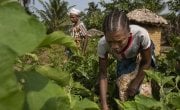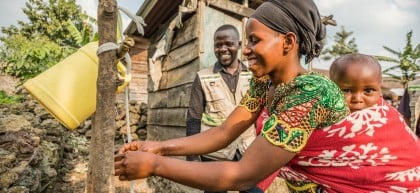
Knowledge Hub
It’s time to wake up to the injustice of global hunger and malnutrition

Access to healthy, affordable food and quality nutritional care is a basic right everyone deserves - no matter who you are or where you live. Yet right now, one in nine people are hungry and undernourished. In light of this year’s Global Nutrition Report, Concern’s Senior Nutrition Policy Officer Caroline explains why 2020 must be a turning point.
This year’s Global Nutrition Report puts a spotlight on the inequity of nutrition. As the world braces itself for a hunger crisis accelerated by coronavirus (Covid-19), this timely report is a warning that governments, businesses and civil society must urgently step up efforts to address malnutrition by tackling injustices in food and health systems.
There are serious weaknesses in food and health systems, which are failing in their provision and care for the most vulnerable – such as women and children who live in extreme poverty, and those living in fragile or conflict-affected places. The fact that one in nine people across the world are hungry or undernourished highlights an injustice, rooted in these complex issues that are currently being compounded by Covid-19.
Progress is slow and unequal

The 2020 Global Nutrition Report finds that stunting (low height for age) still affects 149 million children under five years of age, and wasting (low weight for height) affects almost 50 million children under five years of age.
Progress to meet the commitment to truly leave no one behind and reach the UN’s goal of Zero Hunger around the world by 2030 is frustratingly slow. Not one of the 194 countries are on track to achieve all ten of the World Health Assembly’s global nutrition goals by 2025, which sets an enormous challenge. Time is running out.
Although many countries are facing the double burden of malnutrition – both undernourishment and obesity – if you live in a low-income country you are ten times more likely to be underweight than in wealthier nations.
There are also significant inequalities within countries and populations, one of which is a rural-urban divide. For example, stunting and wasting is more common among children in rural areas, whose mothers have received less formal education.
These gaps in wealth, location, age, gender and education are most common in low- and middle- income countries such as Nigeria, Indonesia and Peru.
Countries can also be burdened by multiple forms of malnutrition, particularly when they’re affected by conflict or other forms of fragility. Action must be urgently taken to address these different causes of hunger and nutrition inequities. The report recommends that more funding and better coordination of aid must support these populations.
Global pandemic exposes weaknesses
The report also argues that the need for more equitable, resilient and sustainable food and health systems has never been more urgent. And that was before Covid-19.
Now we see how the coronavirus pandemic is affecting global food systems, supply chains and the way food is purchased. Stockpiling and a growing demand for food items are creating a strain on global supply chains, while restrictions on trade and movement have had a knock-on effect on availability of food. Restrictive social distancing measures are also affecting agricultural input and yields, which will lead to more severe food insecurity and higher rates of malnutrition in the long term. Price increases will further constrain people’s access to quality, nutritious food.
As the global food chain faces further disruption and food prices rise, availability and affordability will be affected. This will place more stress on poor families to make ends meet when they are hit by higher food costs and a drop in the ability to earn a living. The pandemic has happened at a time of unprecedented global need and our own report Covid-19 and Hunger unpacks the impact it is having on the world’s poorest people.
Concern is working to adapt our programmes wherever possible to protect programme participants and staff. For example, in South Sudan we are taking steps to minimise the number of people in health and nutrition centres at any one time. Staff are being trained on Covid-19 awareness, and being kept up to date on the latest guidance around pregnant women, breastfeeding, infant and young child feeding. Steps like this ensure the virus will not deter families from getting the correct nutritional support for their children.
Transform food and health systems





Poor diets are not the result of personal choice, as many think. More often, it is due to a lack of access and affordability to healthy, varied nutritious food. Only by addressing inequities in food and health systems, and placing nutrition at the heart of social and economic development policies, can we fix the global nutrition crisis.
For instance, better choices around the production of food can shift the agricultural system from a reliance on staple grains like rice, wheat and maize, to more varied and healthier foods, like fruits, nuts and vegetables.
At Concern, we work to address undernourishment, ensure food and nutrition security across our programmes, and promote sustainable agriculture through various livelihood projects.
But it isn’t only the food system that needs to adapt. Most people cannot access or afford quality health care that would help to prevent or treat malnutrition. Spending on nutrition needs to be better integrated into national health budgets.
According to the 2020 Global Nutrition Report, approximately just one quarter of the 16 million children under five years with severe acute malnutrition received treatment in 2017, highlighting the urgent need to address this unfair and unacceptable burden.
Through our pioneering Community Management of Acute Malnutrition (CMAM) approach, which has now become the preferred approach amongst practitioners for tackling malnutrition, we have found ways to help health systems deliver nutrition services more effectively by treating malnourished children in the home. Children who have been admitted to our programme are provided with medical treatment and given a sufficient supply of micronutrient-enriched therapeutic food. We have also developed a CMAM Surge approach in response to seasonal changes or ‘surges’ as we know that in many contexts, the number of children seeking treatment for acute malnutrition peaks during certain months of the year.
Since Covid-19 we have produced guidance to help health and nutrition staff adapt CMAM to ensure essential treatment services for acute malnutrition continue as much as possible while minimising the risk of viral transmission.
Investment in nutrition is needed now more than ever
2020 must be the turning point for nutrition. Investing in nutrition and renewing and expanding commitments is critical if we want to avoid a reversal of gains made. We know there is huge demand for funding across many sectors with pressure on donor and domestic budgets. However we cannot afford to see reductions in resources for addressing malnutrition, especially during the Covid-19 crisis.
That is why we are calling for governments to champion food and nutrition security globally, particularly in the face of escalating food crises and the secondary impacts of events like Covid-19.
In 2013 the first Nutrition for Growth Summit held in the UK set the world on a pathway towards achieving its global nutrition goals. As we wait for news on the rescheduling of the Tokyo Nutrition for Growth Summit, governments must pledge long-term, sustainable commitments that have the greatest impact on hunger.
The world cannot afford to let this moment pass.






